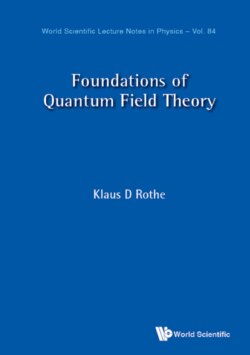Читать книгу Foundations of Quantum Field Theory - Klaus D Rothe - Страница 42
На сайте Литреса книга снята с продажи.
ОглавлениеChapter 5
The Free Maxwell Field
As is well known, the electromagnetic field can be interpreted on the quantum level as a flux of quanta, called photons. In fact, this interpretation first arose in connection with Planck’s formula describing the spectrum of black-body radiation. As Maxwell’s equations show, these quanta propagate with the velocity of light in all inertial frames, so there exists no rest frame we can associate with them. Photons can thus be viewed as “massless” particles. According to our discussion in Section 6 of Chapter 2, the respective 1-particle states should thus transform according to a one-dimensional representation of the little group.
The Aharonov Bohm effect shows that it is the vector potential Aμ which plays the fundamental role in quantum mechanics. This vector potential however transforms under the representation of the Lorentz group and involves a priori four degrees of freedom. Of these, A0 is associated with the “Coulomb potential” and thus corresponds to non-radiative degrees of freedom which are only present if there is a matter source. This leaves us with three degrees of freedom. One of these is not observable (on classical level) as a result of the underlying gauge invariance of physical quantities. For a pure radiation field one is thus left with only two degrees of freedom, corresponding to the two helicity states of a photon. These statements become obvious in the Coulomb gauge, which is thus also called the “physical” gauge. We are, however, not limited to this choice of gauge which in practical calculations complicates matter considerably, due to the fact that it breaks manifest Lorentz covariance. We shall thus review the solutions of Maxwell’s equations in two different gauges — the Lorentz gauge and the (non-covariant) Coulomb gauge.
5.1The radiation field in the Lorentz gauge
In the absence of a source, the Maxwell equations (Coulomb’s and Ampère’s law) become
with the usual identification
for the magnetic and electric fields, respectively.
The electromagnetic field tensor Fμν can be written in the form
and is evidently invariant under the gauge transformation
In terms of the vector potential Aμ the homogeneous Maxwell equations (5.1) read
By choosing Λ in (5.3) to be given by
we arrive at the Lorentz gauge
In this gauge the equations of motion (5.4) read
The general solution of this equation is well known from the course in electrodynamics and is given by
where a(k, ν), μ = 0...3 are the Fourier coefficients and ϵμ are the corresponding polarization tensors playing a role analogous to the Dirac spinors. In the Lorentz gauge (5.5) we must have
With Aμ real, we choose the polarization tensors to be real. The choice of the Fourier coefficients is then dictated by the reality of the electromagnetic field. In particle language it corresponds to the fact that the photon is its own antiparticle!
The Fourier coefficients will eventually be identified with the creation (destruction) operators of 1-particle states. However, only two of these states can correspond to photons of helicity +1 and −1. In the Coulomb gauge this becomes manifest. This gauge, thus often referred to as the “physical gauge”, has however the drawback of not being manifestly Lorentz invariant.
5.2The radiation field in the Coulomb gauge
The Coulomb gauge
can be reached by performing the gauge transformation (5.3) with
In this gauge, the free Maxwell equations for the vector potential read:
Setting μ = 0, it follows from here that
This is Laplace’s equation; it only has the trivial solution if we require that the vector potential tends to zero at infinity. In the Coulomb gauge we thus have in the absence of sources, A0 = 0. This shows that in this gauge the vector potential possesses only two degrees of freedom, corresponding to a radiation field, in agreement with our general considerations in Section 6 of Chapter 2, showing that a zero mass particle can exist only in two helicity states. Correspondingly we have for the general solution of (5.7) in the gauge (5.6)
with , and λ the helicity, where we have used (5.13). We are allowing for both helicity states, since parity is conserved. We now show how to choose these polarization tensors for a real field.
Define the two orthogonal vectors
Introducing as in Section 6 of Chapter 2 the light-like standard 4-momentum k by
describing the motion of a photon in z-direction with energy we see that the standard polarization tensors (5.9) are in fact eigenvectors of the helicity operator
Indeed,
Inspired by our considerations in Section 6 of Chapter 2 on the Little group, we now define the polarization tensors for a photon with general momentum by
where are the elements of the Little group taking the standard vector into the final vector kμ (see Chapter 2),
The boost matrix represents a boost of along the 3-direction to kμ = (|k|, 0, 0, |k|) and leaves the standard polarization tensors unchanged since it only affects the 0 and 3 elements, leaving the (1, 2) elements unchanged. Hence
where we have used
with R the matrix rotating the standard momentum into the direction of . Noting that
we easily verify the following properties of the polarization tensors:
The last property follows from the following manipulations:
where we have used the Lorentz transformation property (2.6) of a covariant 4-vector. The polarization tensor satisfies the following completeness relation:
